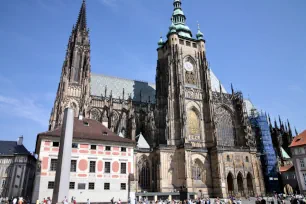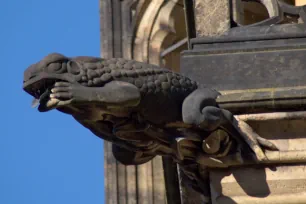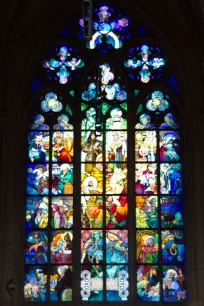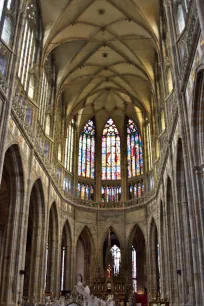The largest and most important church in the Czech Republic, the magnificent St. Vitus Cathedral, stands within the confines of the Prague Castle and is one of Eastern Europe’s finest examples of Gothic architecture.




Officially named St. Vitus, St. Wenceslas, St Adalbert Cathedral, this church, which dominates the skyline of Prague, is the seat of the Archbishop of the city and has long been the site of the coronations of centuries of Czech royals.
Incidentally, only two percent of Czechs practice their religion, so this amazing structure remains basically unused for religious services. It is, however, one of the city’s top tourist attractions.
The Cathedral’s History
In 929 a church was built here at the site of a pagan temple dedicated to the god of fertility Svetovid (Svantovit in Czech). The Romanesque-style, domed rotunda was commissioned by Duke Wenceslas I and consecrated to Saint Vitus. By 1060, when the bishopric of Prague was founded, the rotunda was converted to a triple-naved basilica with two steeples.
Construction of the Cathedral
Construction of the present-day cathedral started in 1344. That year Prague became an archbishopric and King John the Blind decided to build a larger church worthy of this new status. The king died just two years later, but his successor, King Charles IV, actively supported Prague’s ambitions, and he put French master mason Mathieu d’Arras in charge of the ambitious project.
Peter Parler
D’Arras left most of the work undone when he died suddenly in 1352. He was succeeded by Peter Parler, a young sculptor and woodcarver from Swabia, South Germany. Parler followed Mathieu’s designs and then added his own artistic hand to the project. The result was an unusual Gothic style – sometimes called Sondergotik (special Gothic), with touches that were decidedly different from other Gothic masterpieces.



When Parler passed away he had completed the magnificent chancel, the Wenceslas Chapel and the Golden Portal. His sons assumed control of the project, and in 1399 they completed the clock tower and transept. Construction slowed, and it completely ground to a halt with the outbreak of the Hussite Wars in 1419. The tower was partly destroyed in the great fire of 1541, but rebuilt soon after. In 1770 the Italian-Austrian architect Nicolaus Pacassi added a Baroque dome on top of the tower.
Completion
The cathedral was left unfinished until a society of concerned individuals was formed in 1844 in hopes of finally completing the structure, which now needed extensive repairs as well. In 1873 construction of the west facade started under the lead of Josef Mocker. In 1899 Mocker was replaced by Kamil Hilbert, who oversaw the completion of the church in 1929. Many of the plans of Peter Parler were used during this final construction phase.
Exterior
Golden Portal
Before the west side of the cathedral was completed, the Golden Portal (Zlatá brána) was the main entrance to the cathedral. Bohemian royals entered through this portal on coronation day. The colorful mosaic above the portal was created in the fourteenth century by Venetian artisans and depicts The Last Judgment.
Clock Tower
The clock tower, the tallest of the cathedral’s towers, can be seen from all over Prague. The tower’s spire reaches a height of 96.5 meters (317 ft.). The most remarkable about the tower is its top; while most of the tower – and the rest of the cathedral – is of Gothic design, the upper part is in Renaissance style and topped with a Baroque dome. Visitors can climb 297 steps to the top of the soaring tower and view the largest church bell in Eastern Europe. Moreover, those who climb to the top are rewarded with magnificent views over Prague.
West Facade




The west (front) facade of the Saint Vitus Cathedral was built between 1873 and 1929 in a neo-Gothic style. The large rose window above the cathedral’s main entrance was designed by František Kysela. The stained-glass window, completed in 1927, shows biblical scenes.
Interior
Nave
Due to its crammed location in the third courtyard of the Prague castle, it is difficult to get a good view of the church, but once inside the nave – the country’s largest – the impressive size of the cathedral becomes apparent. The large stained-glass windows that allow natural light into the nave date from the early twentieth century. Some are real masterpieces, such as the Cyril and Methodius window, created in the Art Nouveau style by Alphonse Mucha.
Chancel
The chancel, built by Peter Parler, is one of the highlights of the St. Vitus Cathedral. The tremendously high ceiling with a beautiful net vaulting is supported by large flying buttresses. In the middle of the chancel is a royal mausoleum with large pompous tombs designed by the Flemish sculptor Alexander Colyn and created between 1571 and 1589 for Ferdinand I and his wife. Another impressive sepulchral monument in the chancel is the tomb of John of Nepomuk, a Czech martyr. It was designed in 1736 by the Austrian architect Joseph Emanuel von Erlach, who used two tons of silver to create this spectacular monument.
St. Wenceslas Chapel
The most magnificent of the many chapels in the Saint Vitus Cathedral is the St. Wenceslas Chapel, dedicated to the patron saint of the Czech Republic. The chapel, located near the Golden Portal, is one of the most magnificent parts of the church. Constructed in the fourteenth century over the tomb of St. Wenceslas, this chapel is decorated with more than 1,300 semi-precious stones of many varieties. Frescoes on the wall show scenes from the bible and tell the life of St. Wenceslas.
Wenceslas is known in Anglo-Saxon countries from the Christmas Carol the Good King Wenceslas. In reality, he was not a king but a duke, and he was probably not that good either. A part of the nobility opposed him and sided with his brother Boleslav, who killed Wenceslas in 935. Since Boleslav was a pagan, Christians were quick to revere Wenceslas as a martyr and saint.
Royal Crypt
Stairs lead down to the Royal Crypt where the remains of Bohemian royals are buried, including Kings Charles IV, Vaclav I and Rudolph II. The bodies were moved here in the 1930s and placed in new sarcophagi. In the crypt, you can also see some remains of the original tenth-century rotunda that was built here by Wenceslas I.
- Next: Powder Tower
- More Sights & Attractions in Prague

